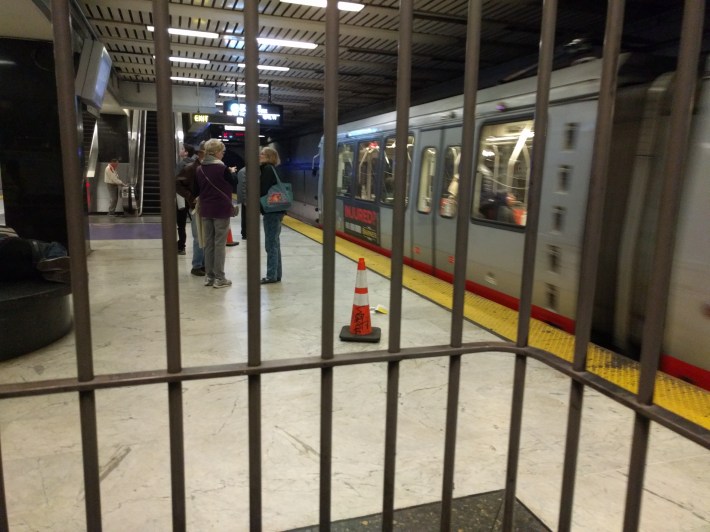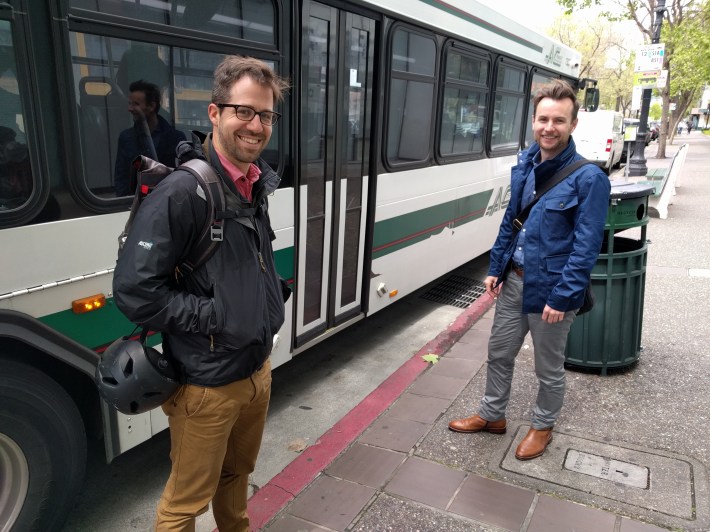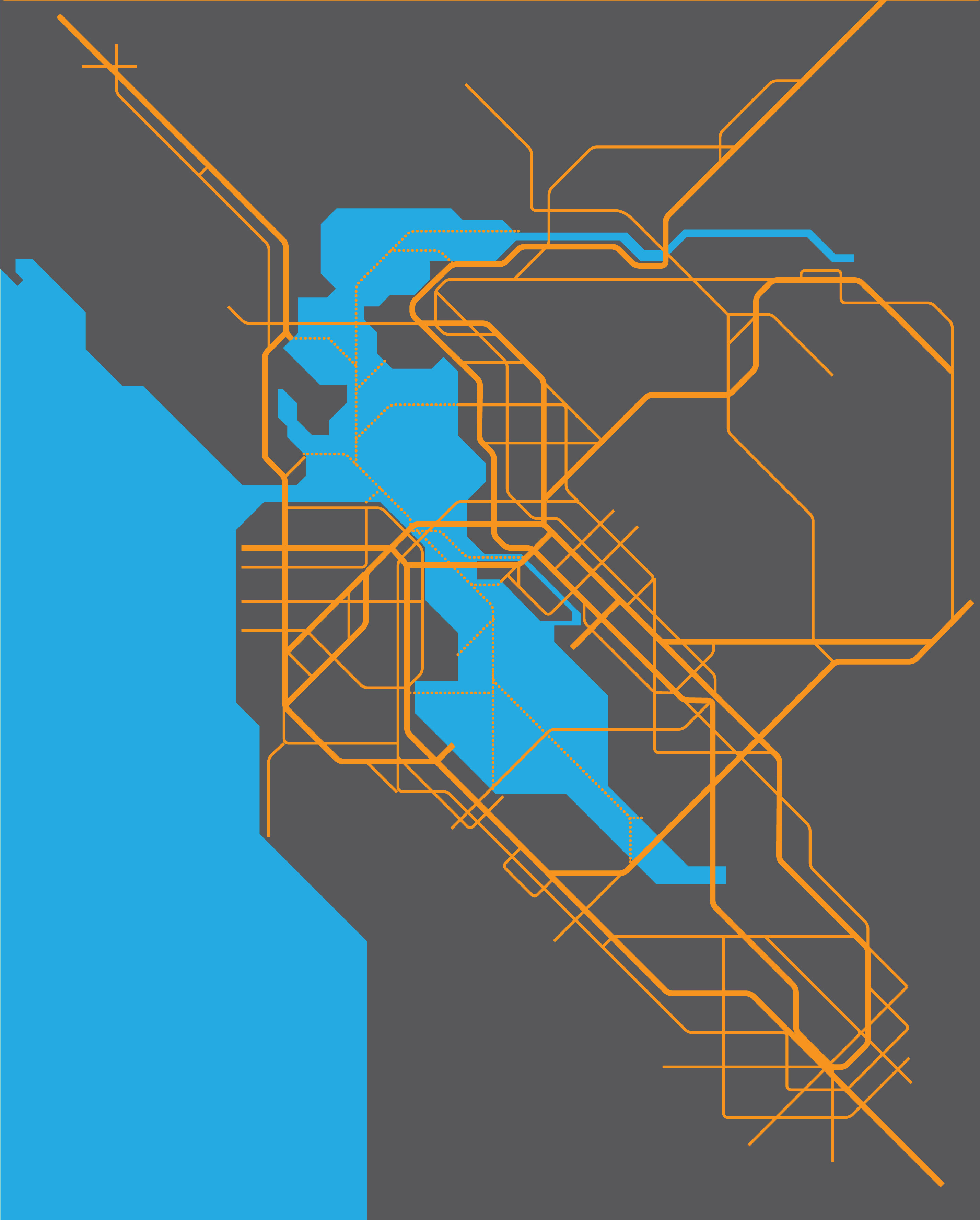Note: Metropolitan Shuttle, a leader in bus shuttle rentals, regularly sponsors coverage on Streetsblog San Francisco and Streetsblog Los Angeles. Unless noted in the story, Metropolitan Shuttle is not consulted for the content or editorial direction of the sponsored content.
Imagine if the Bay Area's 27 transit agencies took the same tickets, billed passengers by the same rate for distance traveled, and all the rail, bus, and ferry systems operated under a single brand as far as the rider was concerned.
That's the dream of Seamless Bay Area, founded in May of 2017 by a group of transportation planners and advocates, including Ian Griffiths and Beaudry Kock. Both have lived and worked in other cities and seen how world-class transit systems can be integrated successfully. But for some reason the Bay Area, along with other American regions, seems incapable of getting its act together when it comes to rationalizing fares and coordinating schedules among different transit agencies.
Streetsblog sat down with Griffiths and Kock to talk about why, what they hope to do about it, and why they decided to start the Bay Area's newest advocacy group.
***
Streetsblog: So for, well, forever, SPUR, the Transit Riders, TransForm, Friends of Caltrain, and many others, including Streetsblog itself, have been banging their heads against the wall trying to get the Bay Area's transit agencies to abandon revenue neutrality, coordinate fares, coordinate schedules, etc. We've got Clipper and a few transfer discounts but so far nobody's been able to really crack this nut. Why will you succeed where everyone else has failed?
Ian Griffiths: I moved away a few years ago to take a job in Toronto, to work for their regional transportation authority, Metrolinx. They’re an effective, and relatively new, agency with the power to mandate regional integration to create a vision for a region. Like the Bay Area, Toronto has multiple transit agencies. But here there's basically nothing going on in terms of vision. So when I got back here--I'm a planner at BART now--I started asking around in my network here and at the nonprofits. They're all saying that no group is really taking on this issue of our flawed governance model.
SB: There's the State Rail Plan. That's a start, if it ever gets done.
IG: That’s exciting. But what I heard from the Transit Riders, from SPUR, Friends of Caltrain, and from TransForm--the more I spoke with them, they said that no organization was taking it on and it’s important and worthwhile to have a group focused singularly and primarily on governance reform.
SB: It's so interesting that the one thing that requires no real big infrastructure should be the hardest to fix.
IG: It's the low-hanging fruit. It's the easiest thing to do. But when it comes to governance, people act like 'you don't touch this.' So in May we formed this group along with a bunch of other transit professionals and advocates because we all want the same thing.
SB: Beaudry, you have a similar story? You used to work for Ford.
Beaudry Kock: After I left Ford, I went to the Massachusetts Bay Transportation Authority, and they have similar problems to the Bay Area. You have a regional operator entity, but from a rider standpoint, if you’re a bus rider you’re treated differently from a train rider, a train rider is treated differently from a ferry rider--and the whole experience for the customer of trying to navigate the systems is crummy and crappy. It's like Millbrae.
SB: Yes, the poster child for bad transit integration--BART, Caltrain, but nothing's coordinated and you can waste an hour transferring from one to the other.
BK: Right. My hope is that this group, if we can just get the agencies to act differently, a lot of this stuff could be done by cooperation rather than legislation. They could plan better, coordinate schedules, operations. SFMTA has all-door boarding on its buses, so why can't that spec be shared with the other Bay Area bus operators? Why is there no sharing of structure and organization funding? We need to get them to think this way, like a Transport for London (TfL).
SB: I lived in London. Right--you have the Oyster Card and a zone fare system, and it doesn't matter if you take the tube, a surface train, it's all the same ticket and the same fare. So that's your vision for the Bay Area--an Oyster Card, zone system?
BK: The fares vary by mode, distance and other factors, but the fare payment system and branding is unified.
IG: The first thing that we need is a bold and inspiring vision of what transportation could be in the Bay Area. We want people to know what it would look like and feel like and attempt to calculate some of the real improvements people would experience in time-travel savings and improved reliability. We want to paint that picture of an excellent future transportation system that’s seamlessly integrated. Then we have to agree on how to get there. State legislation is one path--something that would change how agencies relate to one another and centralize functions such as scheduling and fares, customer experience, and branding. There should be a state mandate to do it at a regional level. We know there’s potentially other ways of getting there, other mechanisms, such as a ballot measure. We will approach each of the agencies separately, but first we want the vision to get excited about because it's harder to come up with excuses for why this is not possible if everyone is excited about it.
SB: I've always thought any ballot measure funding should absolutely mandate regional coordination in order to receive any of the funds. I mean, we need to make it impossible to build another station if it's going to be operated like Millbrae.
IG: Right now the agencies are all planning for a different future. When I look at Muni and BART and they have a new project, it’s depressing to think, even with the planning for a second Transbay Tube, there’s currently no confidence that we’ll be doing things in a better way if and when it's built.
SB: Meaning they'll build a new transbay tube for BART and Caltrain but they'll still run on uncoordinated schedules with different fares. Yeah, that would be depressing.
BK: That's really possible, because we just don’t deal with the issue of governance. Take Transport for London (TfL)--they increased bus ridership 70 percent and subway ridership went up 40 percent just from the consolidation of operations and management and the work of a highly professionalized staff. By contrast, can you imagine Golden Gate Transit hiring a service designer like TfL or Metrolinx did? TfL got a team that built up Oyster.
SB: It is seamless over there. You never really know--or have reason to care as a rider--that you're transferring from agency to agency as you move through the system. So what's London got that we haven't got?
BK: The mayor and political side of the city are woven into the board and direction of TfL, so there’s accountability.
SB: Right. London's Mayor Sadiq Khan is chairman of the TfL Board.
BK: With BART you don’t have an accountable regional system. Who is accountable for actual regional mobility? It's not BART. They consider their responsibility only from the moment you enter the BART station to the moment you leave. We have the appearance of accountability, but all the local agencies resist; they want to keep that local control. We have this fragmented landscape. So nobody is accountable for the region.
SB: What about the Metropolitan Transportation Commission (MTC)? Isn't that their job?
BK: But they have no real supervisory authority.
SB: MTC can’t fire anyone at SFMTA or BART or SMART for not getting with the program.
BK: I don’t think so.
SB: I’ve heard people at MTC say we’d love to push for more integration, but it's not in their mandate.
IG: MTC has existed for 50 years and we have the system we’re in. Something has to change at MTC. Let’s envision the system we want and design the governance to get us there.
BK: MTC is just not empowered to do this. They do planning but with very few teeth.
IG: There might be some simple modifications to the law that can change that. Or we might have to rethink MTC and many other agencies.
SB: Maybe we can just buy an angle grinder and get someone to cut the bars at Civic Center between Muni and BART [note to the BART police below*]. You've heard of tactical urbanism. Do you see room for tactical transit integration?

IG: From a tactical point of view that’s something we think about a lot about. What are some of the small things we can tackle? Beaudry’s term is “tactical seamlessisms”
BK: Yes, like tactical urbanism.
IG: The weird thing is BART owns the whole station. But no one takes responsibility for making sure there is a seamless and convenient transfer for customers. There are things we can do to help people experience what it’s like to not have these barriers. That might help us fix the broader issues. Some members are specifically interested in working on those things.
SB: How many members are we talking about?
IG: There are about 100 on the mailing list and a core of about twenty who are actively involved.
BK: Building grassroots support is really really important to building political support.
IG: We’ve been trying to talk with people within the agencies. There’s been many attempts to fix this from inside, trying to get the board of MTC to talk with BART or Caltrain--to try and fix the problems from the inside, but that's always failed. It’s worth a shot, but we’ve failed at the previous attempts.
SB: So they've integrated transit in Switzerland, Germany, France, the U.K. Why are we so far behind again? It's that governance thing?
BK: There has been an ideological struggle in the U.S. between people who don’t trust government and people who want government to do more. The resulting strong localism rooted in U.S. political history has made it hard to think regionally. U.S. transportation has been a casualty of the larger ideological divide where people don’t trust government, so they split up the power structures. So we end up with 27 different agencies to run one transportation system.
IG: 28 if you add the new Tri-Valley San Joaquin Valley Regional Rail Authority.
SB: 28 now? Oy.
IG: Each agency is grappling separately with TNCs and coming up with their own policies about how to deal with them. Everyone's doing their own original pilot programs around these things. It’s ridiculous that’s not happening on a regional level. The future of public transit is in danger unless we get our act together.
SB: Has any U.S. state managed this kind of regional integration that you seek?
IG: Yes. Georgia just passed legislation mandating the centralization of a number of functions of the transit systems, including a unified brand, and integrated fares across the 13-county Atlanta area. Seattle too... Sound Transit was pushed by a grassroots movement to create more transit and to do the capital planning for the entire region. It was central when they passed their funding measure.
SB: So before any more funding can be released, the transit agencies must sign onto a sort of transit constitution...is that your idea?
IG: A passenger 'Bill of Rights.' It’s about the public funds.
BK: Every missed train or bus connection is a waste of human potential. And that all stems from the agencies failing to do simple things.
SB: Where do you see yourselves in five or ten years?
IG: We don’t want this to be just another advocacy organization. It’s about achieving a goal. Some day we want to cease to exist. It’s a fundamental conversation to have... we need to have it before we start asking the voters for a lot more money. SPUR came up with the Seamless Transit report in 2015, of things to do, and none of these recommendations that were supposed to be low hanging fruit are going anywhere. When you don’t have the governance piece figured it out it is hard to move anything forward.
SB: And that's the key part you aim to fix.
IG: Yup, that's where we come in.

*Metaphorically speaking. And thank you for your service.
This interview was edited.





